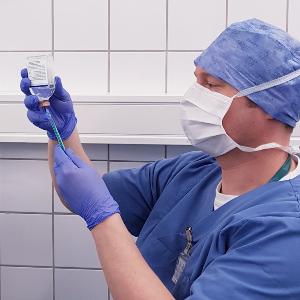
Anesthesia
Every animal is routinely examined by us before each anesthetic, among other things with regard to possible cardiovascular diseases. The anesthesia is then individually adapted to the patient's age and state of health and carried out as gently as possible. Anesthesia is always induced and monitored under the supervision of our specialist veterinarians. Each animal is connected to monitors to monitor its cardiovascular and pulmonary function throughout the anesthesia until it is transferred to the intensive care or recovery unit.
Pain management
As the elimination of pain is a top priority for the comfort of your animal, in addition to loss of consciousness and stable cardiovascular parameters, various regional procedures (local anaesthesia) are also used alongside systemically administered painkillers. Here, too, we respond individually to the needs of each animal. It goes without saying that pain therapy is also included in the post-operative phase.
Our range of anesthesia services includes
- Patient-specific treatment as combination or total intravenous anesthesia (TIVA)
- Multimodal pain therapy
- Local and regional proceedings, including
- Epidural anesthesia
- Plexus anesthesia
- Regional anesthesia in the head area (especially for oral surgery)
- Continuous drip wound infiltration anesthesia
- Infusion management
- Use of modern ventilators and monitoring devices
- Anesthesia management according to the guidelines for anesthesia in dogs and cats
Intensive care
More seriously ill patients receive the best medical care as well as careful attention and care in our intensive care unit during the post-operative course. Changes in our patients' state of health can be recognized quickly and treated appropriately. Repeated laboratory tests and close contact with the animals help us to monitor the success of the therapy and make any necessary changes.
In our intensive care unit we offer your pet:
- Veterinary care "around the clock"
- Modern surveillance monitors
- Possibility of "artificial nutrition" as tube feeding
- Closely monitored pain management
- Needs-based infusion therapy
- Intensive care
